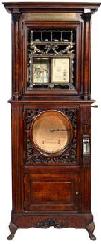 The Yale Wonder Clock is rare. Talk about gimmicks and options.
The Yale Wonder Clock is rare. Talk about gimmicks and options.
This unusual oak clock is about 7 feet tall. It’s a marriage of clock, music box, coin collecting, and arcade machine.
When you insert a nickel-size, stamped aluminum coin lights flash, music plays, and a token drops into a reward cup potentially worth 5¢, 10¢, 15¢, or 25¢.
While all this is happening within the case, three numbered tiny reels spin, generating a random number between 000 and 999.
The store displaying this extraordinary clock probably posted a list of lucky numbers on the wall which gifted winners with a prize. It’s quite the machine.
The inventor, Charles A. Yale, incorporated his company in Burlington, Vermont in 1900. The main product appears to have been this remarkable timepiece.
Less than 1,000 Wonder Clocks were actually made, probably more like 600-700. Of these, only about a handful survive today.
The first coin-operated machine was introduced in Egypt in 215 B.C. Temple goers dropped five drachmas into a slot for a measure of holy water. In the elevated train platforms of 19th century New York; Thomas Adams also marketed his Tutti-Frutti gum through early vending machines.
The Yale Wonder Clock is in a class of its own.
The spinning arrow on the clock which stopped at various locations on the reverse painted numbered glass was one of the things you notice first. Next your eye was drawn to the 15 ½ inch diameter Regina music disc player below it.
Throw in a New Haven Clock Company clock, flashing lights, token awards, original crank, Edison light bulbs, plus music—and you’ve got the whole ball of wax.
Leave a Reply